Easter is the most important Christian festival of the year. Easter celebrates the return to life of Jesus Christ, the founder of Christianity, after his Crucifixion. Jesus’s return to life is called the Resurrection. The Gospels tell that on the morning two days after Jesus’s death his tomb was found empty. Soon, Jesus’s followers began to see him and talk with him. Christians believe Jesus’s Resurrection means that they, too, can receive new life after death. The Easter festival celebrates this belief.
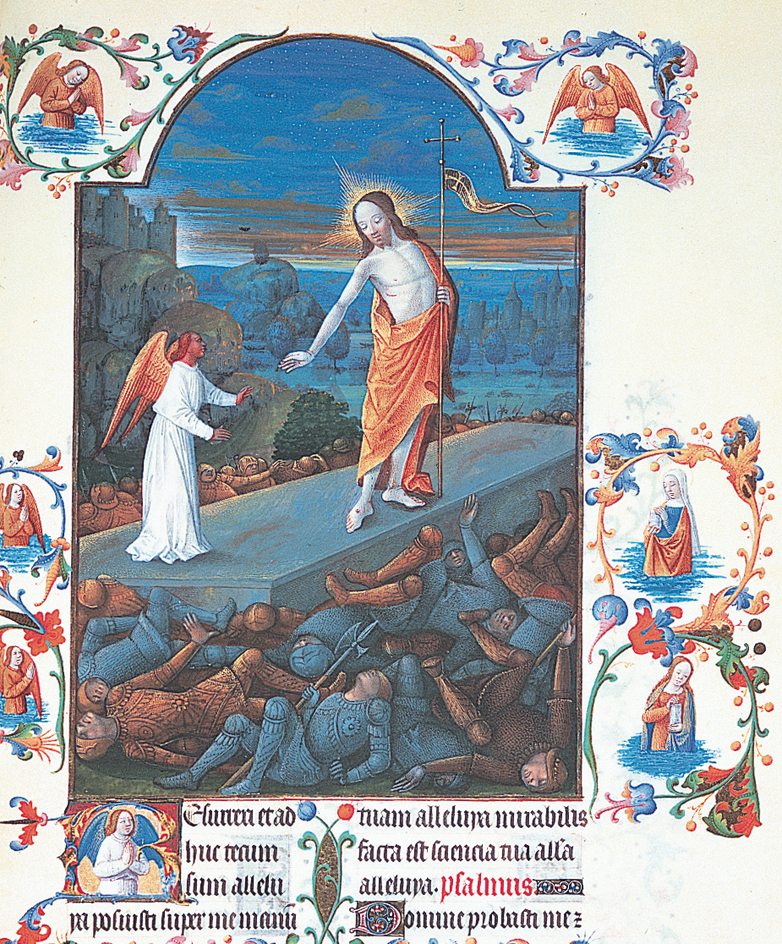
Most Christians observe Easter on the first Sunday after the first full moon following the first day of spring in the Northern Hemisphere. Thus, the festival can occur on any Sunday between March 22 and April 25. In the Eastern Orthodox Churches, the celebration of Easter may take place later because these churches use additional factors in calculating the date of the festival.
The Easter festival is closely associated with spring. The new plant life that appears in spring symbolizes the new life Christians gain because of Jesus’s Crucifixion and Resurrection. The word Easter may have come from an early English word, Eastre. Some scholars say Eastre was the name of a pagan goddess of spring, the name of a spring festival, or the name of the season itself. Other scholars believe the word Easter comes from the early German word eostarun, which means dawn. This word may be an incorrect translation of the Latin word albae, meaning both dawn and white. Easter was considered a day of “white” because newly baptized church members wore white clothes at Easter observances.
Christians in many European countries call Easter Pascha. This word comes from the Hebrew word pesah, which means passover. Jesus was celebrating the Jewish festival of Passover shortly before he was arrested and sentenced to be crucified. Passover recalls how God rescued the Jews from slavery in ancient Egypt (see Passover ). Christians believe that Easter, like Passover, is a time of rescue. They say that by his death and Resurrection, Jesus rescued them from eternal death and punishment for their sins.
Religious observances of Easter
Easter is the center of an entire season of the Christian year. The first and best-known part of the season is Lent, a period of about 40 days before Easter Sunday. Some churches exclude Sundays, and others exclude Saturdays and Sundays, from this period. During Lent, Christians prepare for Easter. They consider it a time for penance—that is, a time to show sorrow for sins and to seek forgiveness. One common form of Lenten penance for Christians is fasting, which limits the kinds or the amounts of food that are eaten. Christians patterned Lent after the 40 days Jesus prayed and fasted in the wilderness to prepare for teaching and leading his people. Easter Sunday is followed by a 50-day period ending on Pentecost, the seventh Sunday after Easter. Pentecost is a festival in memory of the descent of the Holy Spirit upon the apostles.
The beginning of Lent.
In Western churches, Lent begins on Ash Wednesday. Many churches, especially Roman Catholic, Anglican, and Lutheran, hold special services on this day. This service often includes the blessing of ashes on the foreheads of worshipers, and words based on Genesis 3:19, “you are dust, and to dust you shall return.” The ceremony reminds participants that they should begin their Lenten penance in a humble spirit.
In the Eastern Orthodox Churches, members attend an evening service on the Sunday before Ash Wednesday. This Sunday is sometimes called Forgiveness Sunday because at the end of the service worshipers ask the priest and one another for forgiveness for their sins. Lent officially begins in the Eastern Orthodox Churches on the next day, called Pure Monday.
Holy Week
is the final week of Lent. Some churches hold special services every day of the week. Holy Week recalls the events leading to Jesus’s death and Resurrection. For more information about these events, see Jesus Christ (Early life) .
Palm Sunday
is the first day of Holy Week. It celebrates the story of Jesus’s triumphal entry into Jerusalem, where people spread palm branches and clothing before him. During Palm Sunday services, many churches distribute cut palm leaves, sometimes woven into the shape of a cross. Greek Orthodox Christians receive branches of fragrant bay leaves. The leaves are then used in cooking during the year.
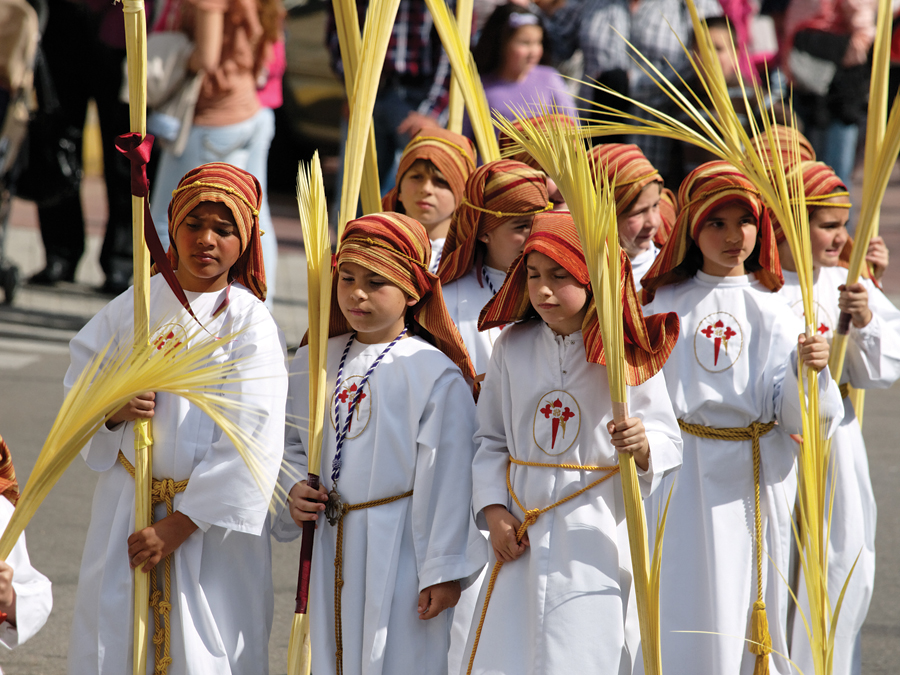
Maundy Thursday,
also called Holy Thursday, recalls Jesus’s last meal and his arrest and imprisonment. Many Protestant churches hold Communion services on this day. During Maundy Thursday Mass, Roman Catholic priests often wash the feet of 12 church members or poor people in remembrance of how Jesus washed the feet of his 12 disciples at the time of the final meal. A priest takes the Host (the wafer of bread regarded as Jesus’s body) from the main altar to a shrine on the side. The shrine symbolizes the place where Jesus was held prisoner after his arrest. All decorations are removed from the main altar as a symbol of the stripping of Jesus’s garments before the Crucifixion.
Good Friday
observes the death of Jesus on the cross. Most churches hold mourning services. Some services last from noon until 3 p.m. to symbolize the last three hours of darkness while Jesus suffered on the cross. The Eastern Orthodox Churches follow services with ceremonies recalling how Jesus was taken from the cross and placed inside a tomb. In many Spanish-speaking countries, Christians hold processions in which people carry statues of the dying Jesus and his mother, Mary. Many Christians eat little or no food on Good Friday.
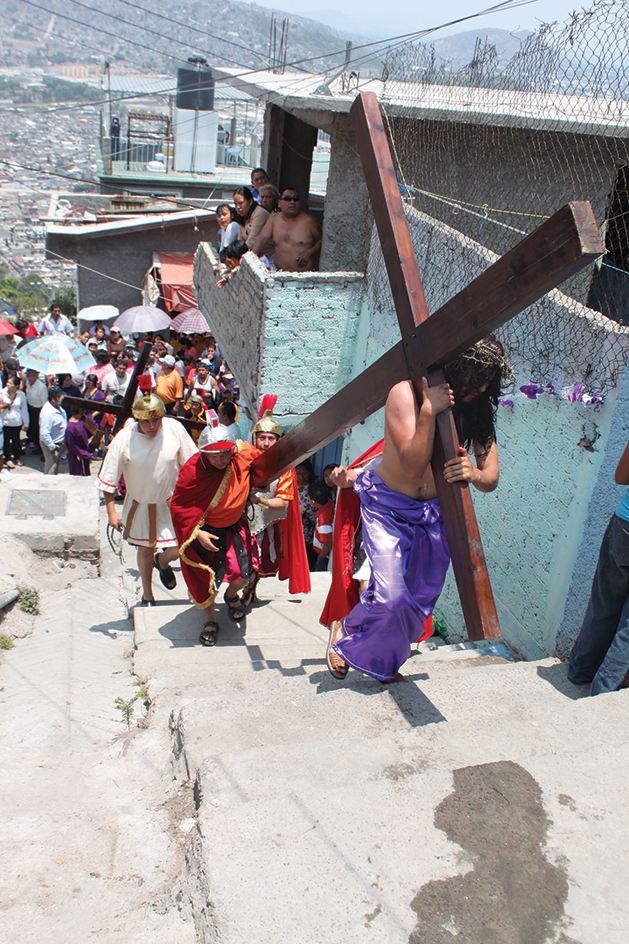
Holy Saturday
is chiefly a day of solemn vigil (watch). The major activity of the day comes at nightfall as observance of the Resurrection approaches. Roman Catholic and Eastern Orthodox churches hold vigil services that often include the baptism of new members. The vigil service leads up to a dramatic moment. The lights in each church are put out, leaving everyone in darkness. Then, the priest lights one tall candle, representing the risen Jesus. The flame from this candle is used to light other candles held by worshipers, which symbolizes the spreading of Jesus’s light throughout the world. In Eastern Orthodox Churches, the ceremony is timed so that the priest lights his candle exactly at midnight. After all the candles have been lit, the service becomes an Easter celebration, with joyous music and the reading of the Easter story from the Bible. Traditionally, newly converted Christians were baptized on this day, after having received religious instruction during Lent.
Easter Sunday
celebrates the Resurrection of Jesus. Roman Catholic and Eastern Orthodox churches hold Saturday evening services, but most Protestant churches wait until Sunday morning to hold their main Easter services. Many churches and communities, particularly in the United States, have additional outdoor Easter services at sunrise. At that time, the light of the rising sun recalls the light that comes back to the world with the newly risen Jesus. Catholic and Orthodox churches also hold additional services on Easter Sunday, especially for those who missed the long services of the preceding night. For many Christians, Easter Sunday is set aside for feasting and celebration.
The end of the Easter season.
During the 40-day period beginning with Easter Sunday, Christians celebrate the time when Jesus reappeared to some of his followers. This period ends on Ascension Day, or Ascension Thursday. On this day, the story of Jesus’s rise to heaven is read in churches. In Catholic churches, the Easter paschal candle is put out on Ascension Day. The Easter season concludes 10 days later with the feast of Pentecost, when the apostles reported that the Holy Spirit had entered into them. Christians believe that the church began at that time.
Easter symbols
Many symbols remind Christians of the original Easter events and their meaning. Most of these symbols are used only during the Easter season. The rest are part of Christian life and worship throughout the year.
The crucifix and the cross
are present in churches and many homes throughout the year. A crucifix is a cross with an image of Jesus’s body hanging from it. It symbolizes the sacrifice Jesus made by allowing himself to be killed. An empty cross—that is, without the figure of Christ crucified—reminds Christians of Jesus’s victory over death and the new life and hope this victory brings to believers.
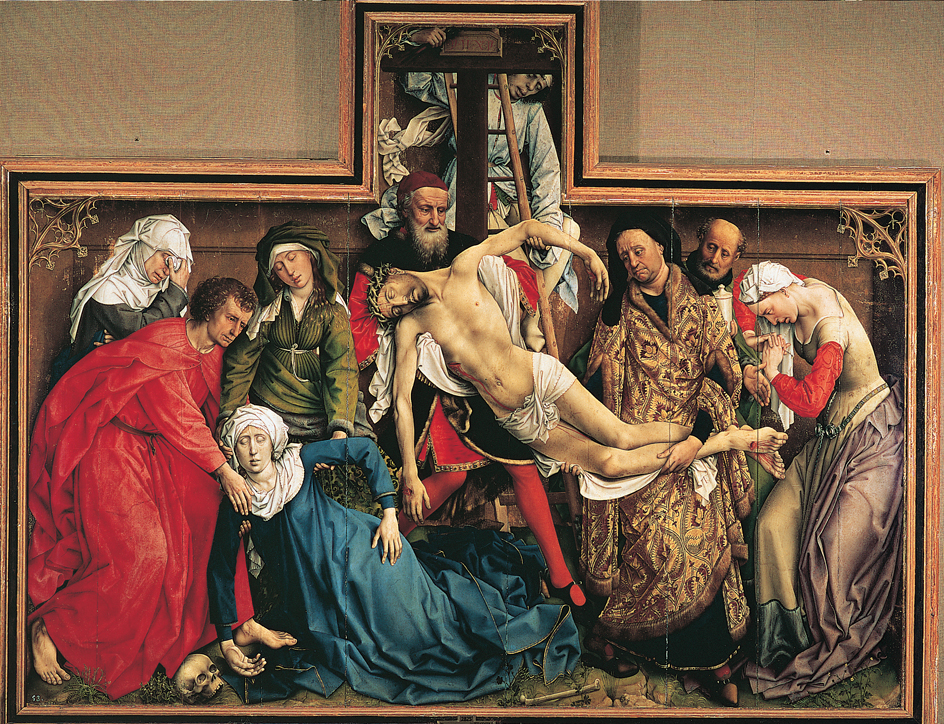
Sunday
is an Easter symbol that is also observed the year-round. Christians traditionally worship on Sunday because that day is associated with the Resurrection.
Candles
are burned during many Easter celebrations, especially the vigil and midnight services before Easter Sunday. Christians associate Jesus with the light from candles, calling him “the Light of the World.” Many churches extinguish candles on their altars on Good Friday to show that Jesus’s light has gone out. In Roman Catholic churches, the special paschal candle is lit on Easter Sunday next to the main altar. The candle represents Jesus’s return to life. The candle is often lit during the next 40 days, until it is put out on Ascension Day.
Easter lilies
are used to decorate churches and homes. The large, pure white blossoms remind Christians of the pure new life that comes to them through the Resurrection of Jesus.

Eggs and rabbits
are the only familiar symbols unrelated to the Easter story. Eggs, which represent new life, have been a symbol of spring since ancient times. Christians adopted the egg as an Easter symbol because of the relationship between Easter and the renewal of life. Rabbits are associated with the fertility of spring because of their ability to produce many young. Some parents tell their children that the Easter Rabbit, or Easter Bunny, brings Easter eggs.
The lamb
is a particularly important Easter symbol in central and eastern European countries. It represents Jesus and relates his death to that of the lamb sacrificed on the first Passover. Christians traditionally refer to Jesus as “the Lamb of God.” Many people serve lamb as part of the Easter feast. In many homes, a lamb-shaped cake decorates the table. Many Eastern Orthodox Christians hang pictures of the Easter lamb in their homes.
Other foods.
Besides lamb and eggs, certain other foods are associated with the Easter season. Pretzels, for example, were originally a Lenten food. Their twisted shape suggested arms crossed in prayer. Hot cross buns, now eaten throughout the Easter season, were first baked in England to be served on Good Friday. The buns have a cross made of icing on the top.
Easter customs
A number of popular customs are observed during the Easter season. Some are followed by most Christians. Others are observed in a particular area or by a particular group.
Carnivals
provide opportunities for feasting and merrymaking before the solemn fast days of Lent. The word carnival comes from the Latin word carnelevarium, which means removal of meat. The most famous carnival is the Mardi Gras, celebrated on Shrove Tuesday, the day before Lent begins. Mardi Gras is a French term that means Fat Tuesday. It refers to the practice of feasting on foods made with fat before fasting during Lent. Carnivals often feature parades in which people wear elaborate costumes. The best-known Mardi Gras parade in North America takes place in New Orleans.

Easter eggs.
Exchanging and eating Easter eggs is a popular custom in many countries. In most cases, chicken eggs are used. The eggs are hard-boiled and dyed in various colors and patterns. Many countries have their own traditional patterns. Probably the most famous Easter eggs are those designed in Ukraine and Poland, where Christians decorate the eggs with complicated red, black, and white patterns.
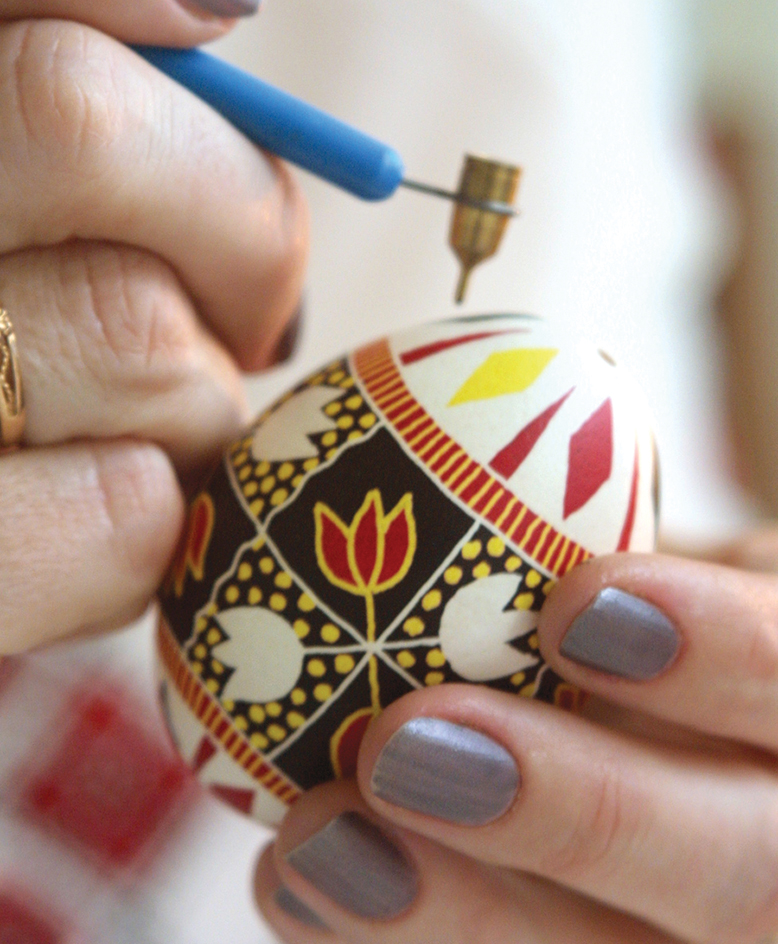
In many countries, children hunt for Easter eggs hidden about the home. Children in the United Kingdom, Germany, and some other countries play a game in which eggs are rolled against one another or down a hill. The egg that stays uncracked the longest wins. Since 1878, children in Washington, D.C., have been invited to roll eggs on the White House lawn.
Passion Plays,
which dramatize the passion (suffering) of Jesus, tell the Easter story. Such plays have been performed during the Easter season since the Middle Ages. The most famous one is usually presented every 10 years in Oberammergau, in southern Germany. It dates from 1634. In the United States, Passion Plays are performed annually in several cities.
Feasting.
Easter Sunday is a feast day. Many Christians in eastern Europe and those of eastern European ancestry in North America have their Easter feast blessed by a priest. The priest may go to the home, or families may take their food to church for the blessing.
Wearing new clothes
for Easter is a custom common among many Christians. It may have originated from the old practice of having newly baptized Christians wear new white clothes for the Easter celebration. Like many other Easter symbols, the new clothes represent the new life offered through the death and Resurrection of Jesus.
Easter promenades
of people in new clothes are a tradition in many European towns and villages. Some of these promenades are led by a person holding a cross or an Easter candle. In New York City, thousands of people stroll in the Easter Parade down Fifth Avenue to show off their new clothes following Easter services.
Other customs.
Many communities follow customs of the Easter season that are special to them. In Bethlehem, Pennsylvania, for example, a trombone choir of the Moravian Church plays hymns throughout the city before dawn on Easter Sunday to call church members to a sunrise service in the old Moravian cemetery. At the cemetery, the trombones play a joyful chorus as the sun appears on the horizon.
